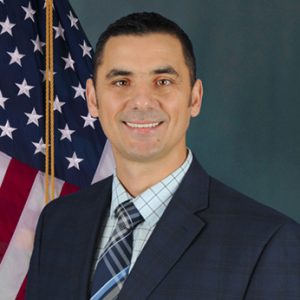
The Veterans Affairs medical center on Seventh Street and Indian School Road in Phoenix. (Photo by Jack Orleans/Cronkite News)

Lane Lamoreaux’s notebook. (Photo by Jack Orleans/Cronkite News)
PHOENIX – The Department of Veterans Affairs has been using telehealth since 2003, long before the larger health care community turned to it during the COVID-19 pandemic. Telehealth has been a lifeline to veterans who live too far away to access health care facilities or have physical limitations that keep them housebound.
In 2023, the VA celebrated the 20th anniversary of its telehealth office and announced that more than 2.3 million veterans had used telehealth services in fiscal 2022, which represented about a third of all vets receiving health care from the VA that year.
“Even before the COVID-19 virus hit the United States in March 2020, VA had established itself as the nation’s largest provider of telehealth care,” according to the VA website.
When the VA started telehealth in 2003, it put devices in people’s homes to measure vital signs, according to Dr. Leonie Heyworth, deputy director for clinical services in the VA’s Office of Connected Care. She said having the machine’s recorded information enabled VA doctors to manage veterans’ chronic conditions, like heart disease, by checking blood pressure, heart rate, weight and other measurements.
Lane Lamoreaux, a former Marine lance corporal, is one of the veterans who was able to take advantage of the VA’s telehealth care. Lamoreaux was diagnosed with epilepsy in 2015 after having his first two generalized tonic-clonic seizures, formerly known as grand mal seizures. At the time, he was living in Boise, Idaho, and he needed a neurologist who specialized in epilepsy, Lamoreaux said.
“The Boise VA simply did not have a neurologist that specialized in epilepsy. The closest one was in Portland, Oregon. So, she (the Oregon doctor) became my neurologist, and we had our appointments via telehealth,” Lamoreaux said.

Lane Lamoreaux, a former Marine lance corporal, depended on the VA telehealth system to connect him to a neurologist specializing in epilepsy. (Photo by Jack Orleans/Cronkite News)
Lamoreaux’s first appointments with the neurologist were via phone calls but he was able to switch to videoconferencing when the VA started using it in 2017. He did so from his local VA facility with an on-site doctor in the room with him. This was possible because the VA coordinated the necessary on-site and telehealth services.
These kinds of integrated services became part of how the VA uses telehealth through its clinical resource hubs (CRH), according to Heyworth. These hubs are not physical places for patients to go to, but rather a way to connect them to specialists they need to see but can’t access.
The CRH program splits the nation into regions and brings together specialists in each region who can see patients virtually. Launched in 2019, there are now 18 clinical resource hubs nationwide, delivering care in over 50 different specialties including cardiology, dermatology, nephrology and gastroenterology, Heyworth said.
The CRHs give veterans the option of doing their video conferencing from their own home if they can’t go into a local VA clinic for a supervised appointment, said Dr. Valentin Rivish, the national synchronous telehealth content development specialist at the VA.
Rivish also highlighted two care programs offered through VA telehealth. The national TeleCritical care program, which delivers care to intensive care units from critical care doctors all across the country; and the Telestroke program, which delivers stroke care by stroke neurologists in emergency departments.

Dr. Valentin Rivish, the national synchronous telehealth content development specialist at the VA. (Photo courtesy of the Department of Veterans Affairs)
If veterans don’t have good access to Wi-Fi in their own homes, they can go to designated places in rural areas to access Wi-Fi, according to Heyworth and Dr. James Robbins, chief medical officer of TriWest Healthcare Alliance.
TriWest contracts with the VA to find local providers, who see patients through telehealth and in person. Robbins oversees this as well as clinical quality, medical management and behavioral health.
“When the VA, within their own internal resources, can’t provide care, they send it to community providers, and we facilitate that process. We (TriWest) maintain a provider network, we monitor them for quality, and we make claims and things like that for the VA,” Robbins said.
For veterans who don’t have a local VA clinic or don’t have good Wi-Fi connection in their homes, the VA collaborates with local businesses in rural areas to provide soundproof booths with high-speed internet connection that veterans can use for their appointments, Heyworth said. This program is called Accessing Telehealth Through Local Area Stations (ATLAS).
One of these facilities is in Wickenburg, which is about 65 miles northwest of Phoenix. The VA facilities in Arizona include hospitals in Phoenix, Prescott and Tucson, as well as dozens of clinics.
According to Robbins, when telehealth started in the early 2000s, a lot of medical professionals were wary of it because it meant patients were at home and couldn’t make personal connections with their doctors; mental health professionals were particularly apprehensive. Now it has become commonplace, especially in mental health care.
Telehealth can be a great asset for appointments like follow-up visits, where a patient is discussing test results or a care plan, or when a patient has mobility issues, Robbins said.
“A lot of those folks really wouldn’t even get care, right, if they have mobility issues, if they have transportation issues, the list goes on and on of issues that people can’t make it into the doctor,” Robbins said. “For them, it’s not telehealth versus going in, in person, it’s telehealth versus nothing.”
Robbins emphasized that telehealth should not be forced on patients but that it “gives many more people the access they might not otherwise have, to care and specialists.”
This is where the VA’s videoconferencing and clinical research hubs can help a lot of veterans.
Lamoreaux also benefited from asynchronous telehealth, known as Store & Forward. This is when a doctor and patient are not interacting in real-time, but a veteran can send pictures or messages to a phone application or website to have their prescription filled or have a doctor look at problems like skin lesions for teledermatology.
From there a doctor can decide on a course of treatment or whether or not the patient needs to come to an in-person visit, Heyworth said.
Lamoreaux said he has been using this form of telehealth to fill his prescriptions at myhealth.va.gov.
Lamoreaux is currently a second grade humanities teacher at the charter school BASIS Scottsdale Primary West. He said that since his job has some of the same holiday closures as the VA, it’s hard to go in for refills, and being able to have them refilled online has made his life much easier.
When asked if he had any final thoughts about the VA, Lamoreaux emphasized that he loves the centralized care it provides.


